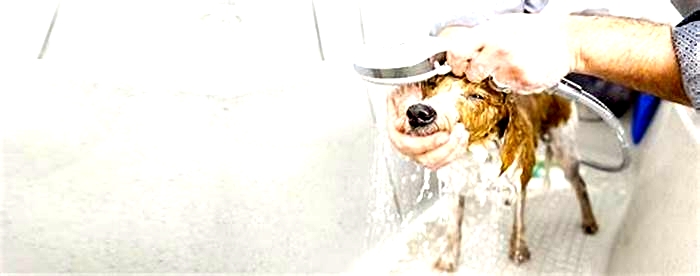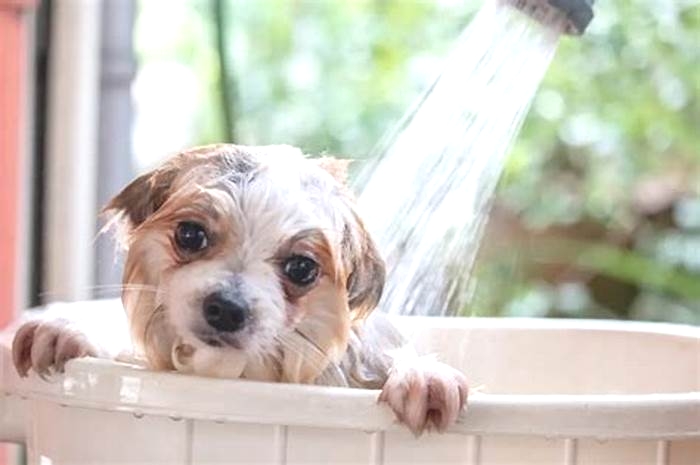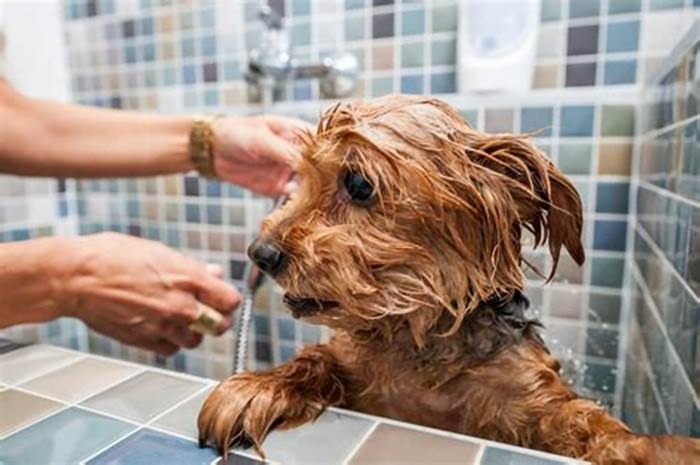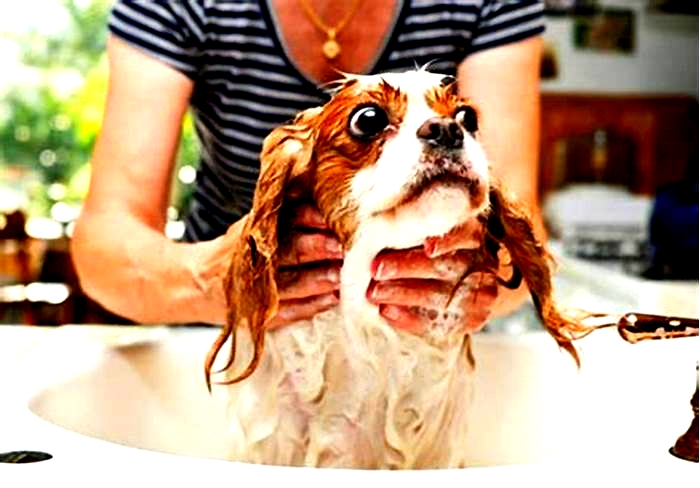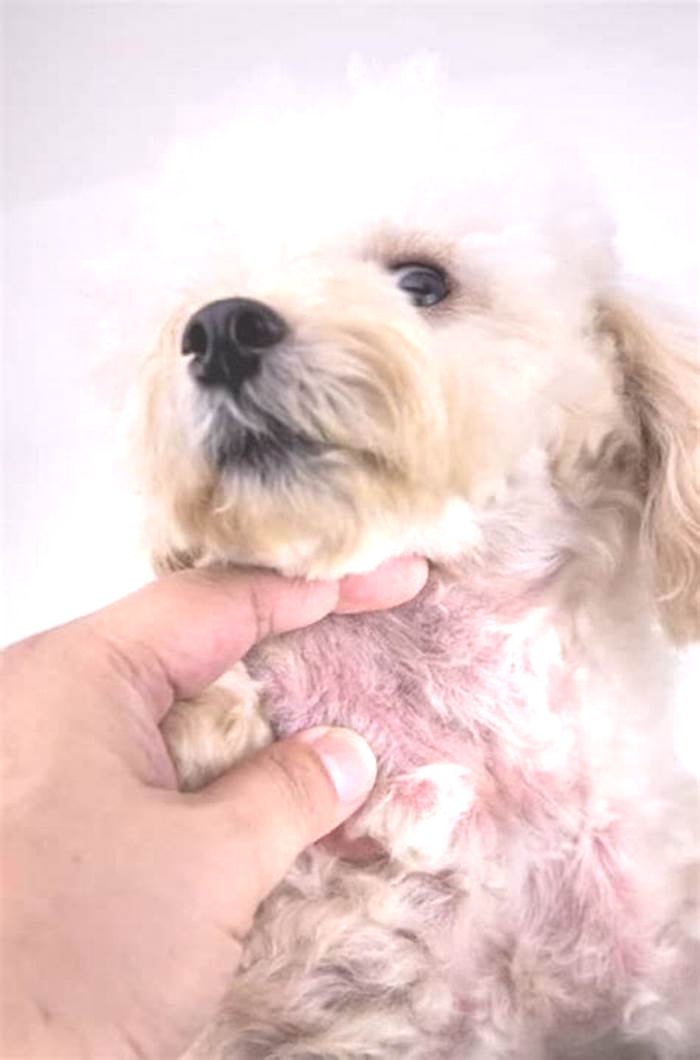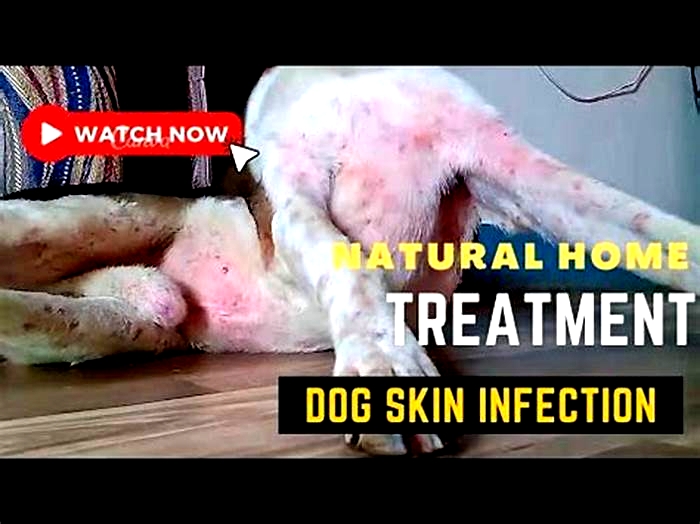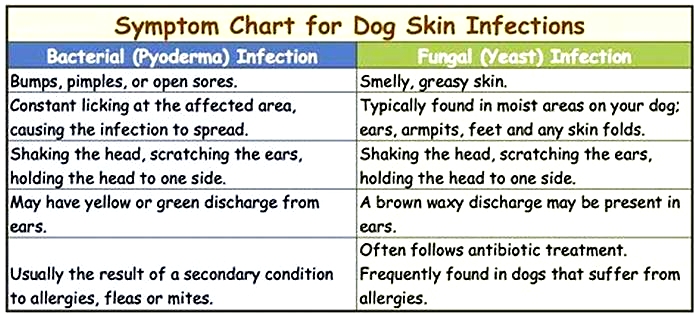Can you wash a dog with a skin infection
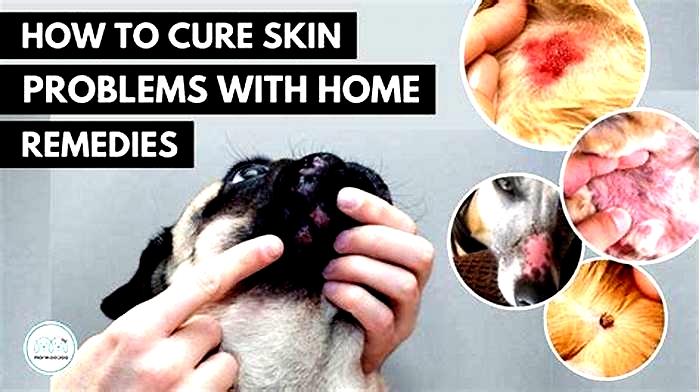
Skin Infection in Dogs
Skin infections can be distressing and uncomfortable for both your dog and you. Quick action can be crucial to prevent the skin infection from developing, or spreading. Dogs can repeatedly scratch a sore area, causing further damage, which can take a long time to heal. Certain breeds are more prone to skin infections than others, so be particularly vigilant if you have a breed of dog that has a predisposition toward skin infections. Breed characteristics such as heavy skin folds, or long droopy ears can be more prone to skin infections. Good care of your dog will include regular checks of his skin health.
How Do I Know if My Pet Has a Skin Infection?
The indicators for skin infections are fairly clear. As always, it is important to look for changes from your dogs normal, as all dogs are different. Key points to look for are:
- flaking or scaly skin
- redness and itchiness
- seeping blood or pus
- spots or pustules
- swelling or heat
- bad smell
- hair loss, or hair standing on end
- thickening of the skin
- brown nails
If you are in any doubt as to the skin health of your dog, it is always best to seek veterinary advice.
What Do Skin Infections Look Like in Pets?
As a responsible dog owner, you will know your dog. You will spot changes in behaviour, which can give you an early indication of an issue. Excessive licking or scratching is always a key thing to watch out for. If your dog seems lethargic or loses his appetite, then this could be an indication of an infection. If your dog begins exhibiting any behaviour that is out of the ordinary, always consider skin infections as a possible cause and carry out a thorough examination of your dog.
Types of Skin Infections in Dogs
When we treat skin infections in dogs, we need to provide the appropriate treatment for the type of skin infection. The treatment will vary according to the root cause, and this is why it is crucial that you visit your vet if you suspect that your dog has a skin infection so that he can receive the correct, tailor-made care for his condition.
Bacterial skin infection in dogs
Bacterial skin infections, known as pyoderma, occur when the bacteria that normally live harmlessly on the skin, get under the skin and cause an infection. This may present as red, circular patches on the skin, that may smell. Your vet will examine the area, and take a swab to check the type of infection. Bacterial skin infections are normally treated with antibiotics, sometimes in combination with an antibacterial shampoo.
Dog fungal skin infections
Fungal skin infections, such as ringworm, often present as flaky or crusty skin that is extremely itchy. They are commonly found around skin folds, armpits, or near the anal area. Again, your vet will diagnose your pet using a combination of examination and a swab to determine the type of skin infection. Fungal skin infections can be treated using a combination of antibiotics and antifungal shampoos.
Parasitic skin infection in dogs
Scabies is a common example of parasitic skin infection, where the symptoms are caused by mites. This will usually present as hives, oozing lesions, or hair loss. Your vet will examine your dog, and take a skin sample for confirmation of the diagnosis. Treatment will depend on the type of parasite. Fleas and ticks are usually treated using a spot-on style treatment, whilst ear mites may be treated with a topical medication.
Viral skin infections
The most common viral skin infections are papilloma-type and can regress spontaneously. However, some viral skin infections will need to be treated with antivirals. Your vet will take a skin swab to determine the type of infection and advise on the best treatment approach, based on the diagnosis.
Prevention of Infection and General Skin Care
As always, prevention is better than cure, and keeping your dogs fit and healthy, will help to reduce the risk of skin infections developing. If you have a breed of dog that is particularly prone to skin diseases, then it is important to be extra vigilant to prevent skin infections from developing. Good health starts with good nutrition, so ensure that you feed your dogs a good diet, avoiding cheap food that is packed full of preservatives and food colourings. Check out the nutrition recommendations for your breed, as this can vary. If you are in doubt about the best way to feed your dogs, please speak to your vet.
Regular grooming will help to keep the dogs skin and hair in good condition, as well as giving you the chance to thoroughly examine your dogs. Make sure you pay particular attention to skin folds, and areas such as the armpits and ears, where it is easy for skin infections to flourish. If your dog is wet or muddy, make sure that you dry and clean key problem areas. Damp or dirt can get trapped, which can allow infections to develop. Good care can help to prevent skin disease in dogs from occurring.
However, some dogs are prone to infections and some infections are extremely virulent, so sometimes your dog will contract an infection, even with the best care in the world.
When to Seek Veterinary Care for Your Pet?
If you are uncertain whether your dog needs to see a vet, always get in touch. Our experienced and helpful team of vets will be able to advise you on the best course to take. We are here to help, and we would rather see your pet if you are unsure than for you to wait while the infection develops, and then it may be harder to treat. The earlier we can catch a problem, the better. If you suspect that your pet is developing a skin infection, please book an appointment to bring them in and get them checked out by our vet team.
Whether your dog has a suspected skin conditions,, or you are managing a long-term underlying skin disease, we are here to assist with all your veterinary dermatology needs. To book your dog an appointment, simply contact our team at Anrich Vets today on 01942 242001
Bleach Bath For Dogs [Usage & Safety Precautions]
To give a bleach bath to a dog, mix a very mild solution of bleach and water (around 0.05% concentration, or 1 teaspoon of bleach per gallon of water). Carefully bathe the dog, avoiding their face and eyes, and rinse thoroughly with plain water afterward to ensure no bleach residue remains.
Key Takeaways
- Bleach baths involve a diluted bleach solution to manage skin conditions in dogs.
- Proper dilution and application techniques are crucial for safety and effectiveness.
- Benefits of bleach baths include reducing harmful bacteria, soothing inflammation, and relieving itching.
- It is important to consult with a veterinarian and follow safety measures to avoid adverse reactions.

Bleach Baths for Dogs: Safety and Dilution Matters
Bleach baths for dogs involve a diluted bleach solution to help manage skin conditions, but its crucial to understand the proper dilution and application techniques to ensure your pets safety.
When youve got a furry friend suffering from irritating skin issues, you might feel at a loss. However, a properly administered bleach bath can be a game-changer. Its all about that sweet spot of dilutiontoo strong and its harmful, too weak and its ineffective.
The Benefits of Bleach Baths
The benefits of bleach baths are pretty clear. They can significantly reduce the presence of harmful bacteria on the skin, soothe inflammation, and provide relief from itching and discomfort.
Its not a cure-all, but it can be a valuable part of a comprehensive skin care regimen, especially for dogs with recurrent skin infections.
Frequency and Balance
Now, you might be wondering how often you can safely give your dog a bleach bath. The recommended frequency is typically once a week, but this can vary based on the severity of your dogs condition and the advice of your vet.
Its paramount to strike a balancefrequent enough to maintain the benefits but not so often that it disrupts the natural balance of your dogs skin.
Mixing the Right Bleach Solution: A Crucial Step in Dog Skin Care
Now that weve explored the benefits and frequency of bleach baths for dogs, lets focus on how to accurately mix the bleach solution to ensure safety and effectiveness.
Getting the bleach concentration right is crucial. A slight miscalculation can either weaken the solutions effectiveness or, worse, harm your dogs skin.
So, youll want to aim for a 0.05% bleach concentration, which translates to 1 teaspoon of bleach in a gallon of water.
Choosing the Right Tools
Choosing appropriate tools for mixing and applying the solution is equally important. Youll need:
- A clean, gallon-sized container for mixing
- A measuring teaspoon
- Protective gloves for your hands
Remember, safety first for both you and your pet.
Mixing Tips
When mixing the solution:
- Ensure the bleach is regular, unscented household bleach.
- Avoid using bleach with added cleaners or scents, as these can be harmful to your dog.
- Mix in a well-ventilated area.
- Outdoor spaces are ideal to avoid inhaling fumes.
Testing Before Bathing
After preparing the solution, test it on a small area of your dogs skin to check for any adverse reactions before proceeding with the bath. If your dog shows any signs of discomfort or irritation, rinse off the solution immediately with plenty of water and consult your vet.
Safely Administering a Bleach Bath for Your Dog: Protective Measures
When administering a bleach bath to your dog, its crucial to prioritize their safety by wearing protective gloves and avoiding sensitive areas like the face and eyes.
Safety precautions are paramount not only for the well-being of your furry friend but also to ensure that the process is effective without causing any harm.
Using the Right Products and Dilution
First off, make sure youre using the recommended products for the bleach solution. A standard household bleach thats chlorine-based and unscented is typically suitable, but its essential to dilute it correctly.
The ideal concentration is about 0.05%, which translates to 1 teaspoon of bleach per gallon of water. This mild solution minimizes the risk of irritation while still providing the desired antimicrobial effects.
Testing for Reactions
Before starting, test the solution on a small patch of your dogs skin to check for any adverse reactions. If theres no irritation after a few minutes, you can proceed but continue to monitor your dog closely throughout the process.
Its also advisable to consult with your veterinarian beforehand, especially if your dog has a history of skin sensitivities or allergies.
Taking Protective Measures
During the bath, keep the solution away from your dogs head to prevent any accidental splashes into their eyes or mouth.
After applying the bleach solution, its critical to rinse your dog thoroughly with plain water to remove all traces of bleach. Ensuring that no residue is left behind will avert potential skin issues or discomfort.
Following these safety measures and using the recommended products will help make the bleach bath a safe and beneficial experience for your dog.
Step-by-Step Guide: How to Give Your Dog a Safe and Effective Bleach Bath
Lets dive into the detailed steps to safely give your dog a bleach bath, ensuring a smooth and effective process.
First, youll need to prepare the bath. Remember, achieving the proper dilution is crucial to avoid harming your dogs skin.
- Prepare the Bleach Solution: Mix 1 teaspoon of bleach with 1 gallon of water to create a 0.05% solution. Its essential to get this dilution right for your dogs safety.
- Wet Your Dogs Fur: Use lukewarm water to thoroughly wet your dogs coat, avoiding the face and ears. This step ensures the bleach solution distributes evenly.
- Apply the Bleach Bath: Carefully pour the diluted bleach solution over your dogs body, starting from the neck down. Avoid the head entirely to prevent the solution from getting into your dogs eyes or ears.
- Let It Sit: Allow the solution to remain on your dogs coat for a few minutes, but no longer than 10 minutes to prevent skin irritation.
- Rinse Thoroughly: Its critical to rinse your dog with plenty of clean, lukewarm water to remove all traces of bleach from their fur.
- Apply Dog Shampoo: After the bleach bath, use a gentle dog shampoo to cleanse your dogs coat. Rinse well to ensure no shampoo residue remains.
- Dry Your Dog: Use a towel or a low-heat hair dryer to dry your dog thoroughly, making sure theyre completely dry to avoid skin issues.
Aftercare and Rinsing: Ensuring Your Dogs Comfort Post Bleach Bath
Proper aftercare and thorough rinsing are essential steps to ensure your dogs safety and comfort following a bleach bath. Once youve completed the bath, its crucial to rinse your dog with plenty of plain water.
This step removes any bleach solution that might linger on their skin or coat, potentially causing irritation or discomfort. Pay extra attention to areas that are easy to overlook, such as under the armpits, the belly, and between the toes.
Your dogs reaction post-bath is a clear indicator of how well the rinsing was performed. If they seem itchy or uncomfortable, it may mean that some areas werent rinsed thoroughly.
Pat Dry With a Towel
After rinsing, gently pat your dog dry with a towel. Avoid rubbing their skin, as it could be slightly more sensitive after the bleach bath.
Observe your dog closely in the hours following the bath. Any signs of discomfort or unusual behavior should prompt a call to your veterinarian.
Frequency and Overuse Concerns
The frequency of bleach baths is another critical aspect of aftercare. These baths shouldnt be a regular part of your dogs grooming routine but reserved for specific health conditions as recommended by a vet.
Overuse can lead to skin dryness, irritation, or more severe complications. Typically, a vet might suggest a bleach bath no more than once a month, depending on the issue at hand.
Risks and Precautions: Understanding the Potential Dangers of Bleach Baths
While aftercare and rinsing are crucial for your dogs comfort, its equally important to be aware of the potential risks associated with bleach baths. Despite their effectiveness in certain situations, the risks of using bleach on dogs cant be overlooked. Its essential to weigh these risks against the benefits before proceeding.
Firstly, bleach is a harsh chemical, and even in diluted form, it can cause irritation or chemical burns on your dogs skin, especially if not rinsed off thoroughly. Its paramount to ensure the solution is weak and applied carefully to avoid any harm.
Chemical exposure is another concern. Inhaling bleach fumes can be harmful to both you and your dog. Its vital to use bleach baths in well-ventilated areas and to avoid your dogs face and eyes to prevent respiratory issues or eye injuries.
Here are some precautions to take:
- Alwaysconsult with a vet before considering a bleach bath for your dog.
- This ensures its a safe option for your pets specific condition.
- Your vet can provide guidance on the correct bleach concentration.
- Conduct a patch test before a full bath.
- Apply a small amount of the diluted bleach solution to a small area.
- Monitor for any adverse reactions over 24 hours.
Monitoring Your Dog for Adverse Reactions: Signs of Discomfort
Recognizing the signs of adverse reactions in your dog after a bleach bath is crucial for their safety and wellbeing. While a very mild bleach solution can be used for specific skin conditions under veterinary guidance, its essential to monitor your dog closely for any negative reactions. These can range from mild to severe, depending on your dogs sensitivity and potential allergies to the bleach.
Indications of Discomfort
After the bath, watch for any signs of discomfort or distress in your dog. This includes excessive scratching, redness, or inflammation of the skin.
You might also notice your dog seems unusually lethargic or agitated, which can be a sign of a more systemic reaction.
Respiratory distress, such as wheezing or difficulty breathing, although rare, would indicate a severe allergic reaction requiring immediate veterinary attention.
Behavioral Changes
In addition to these physical signs, behavioral changes can also suggest discomfort or pain. If your dog is usually active and playful but suddenly becomes withdrawn or shows reluctance to move, it could indicate that the bleach bath has caused skin irritation or discomfort.
Always err on the side of caution when it comes to your dogs health. If you observe any of these symptoms after a bleach bath, its crucial to rinse your dog with plenty of clean water immediately and consult with your veterinarian. They can provide advice on soothing the irritation and, if necessary, prescribe treatments for any potential allergies or adverse reactions your dog mightve experienced.
Alternatives to Bleach Baths: Safe and Natural Remedies for Dog Skin Issues
If youre hesitant about using a bleach solution for your dogs skin issues, there are several safe and effective alternative remedies to consider. These natural alternatives offer a gentler approach, though its crucial to weigh their pros and cons.
Soothing Coconut Oil
One popular option is coconut oil, known for its antimicrobial and soothing properties. It can be applied directly to your dogs skin, helping to alleviate dryness and irritation.
Anti-Inflammatory Oatmeal Baths
Another choice is oatmeal baths, which are renowned for their ability to calm inflamed skin and provide relief from itching.
However, while these alternatives are less harsh than bleach, their effectiveness can vary depending on the severity of your dogs condition.
Its always best to consult with a veterinarian before trying new treatments, especially if your dogs skin issues are persistent or severe.

